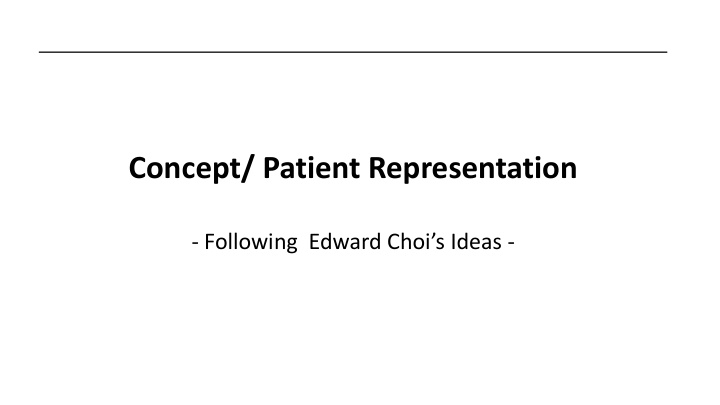



Concept/ Patient Representation - Following Edward Choi’s Ideas -
Introduction • Diagnosis, treatments, and medication codes create thousands of dummy variables (one-hot encoding) -> Sparse matrix • Statistical models usually re-group(coarse classing) dummy variables. Concept • NLP techniques(word embedding) for medical concepts. Representation • ‘Word2Vec’ provides a few interesting features such as vector operation. • Prediction models in general require patient level data (i.e. disease prediction) • Concept representation can be transformed to patient presentation. Patient ✓ However, summation/average of concept vectors loses temporal Representation information as well as interpretability. • E. Choi tries to incorporate sequential information whilst making the models interpretable at the same time.
Concept Presentation Medical ‘Word2Vec’
Concept Representation to Patient Presentation Word Embedding (NLP) No Interpretation! No Time Sequence!
Multi-Layer Representation Learning for Medical Concept Mr.Choi names this architecture as Med2Vec! Probably it is difficult to build a sequential model using medical concepts only. (lost of dups concepts) Let’s bring a ‘visit’ layer to the concept representation learning. Predict pre and post visit data Visit representation + Demographic data Visit data containing medical concept medical concept (diagnosed as gastritis)
AutoEncoder Patient Presentation – Deep Patient Stacked Denoising AutoEncoder -> Good idea, but no interpretability and no temporal info !
Retain – Interpretable and Predictive Model Let’s have interpretability(Attention) and sequential information(RNN).
Retain – Interpretable and Predictive Model Let’s unfold the RNN model.
Retain – Interpretable and Predictive Model
APPENDIX
Stacked Denoising AutoEncoder
Recommend
More recommend